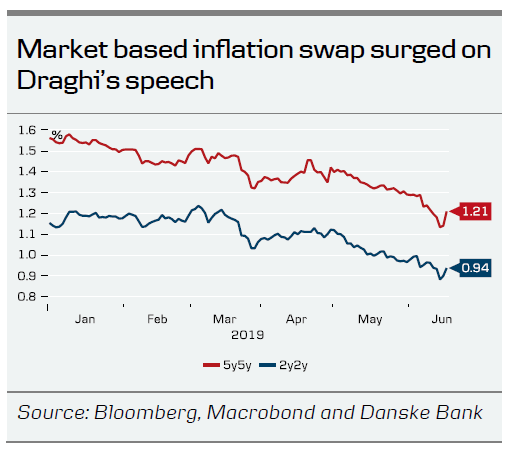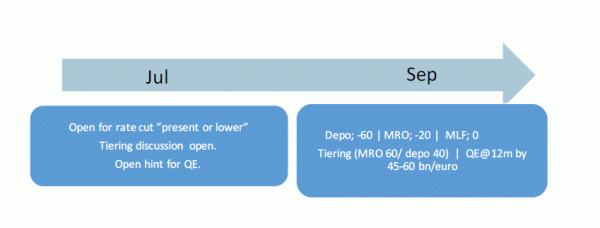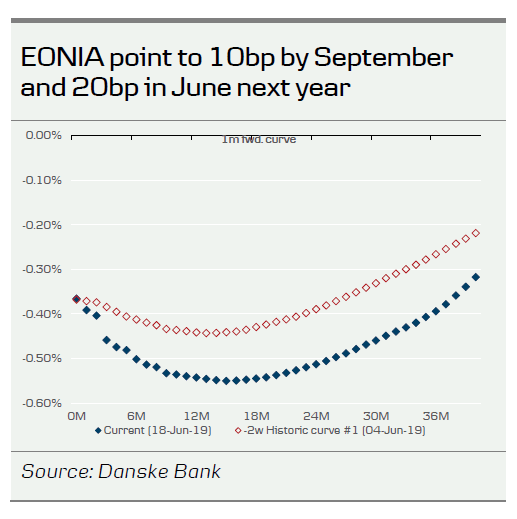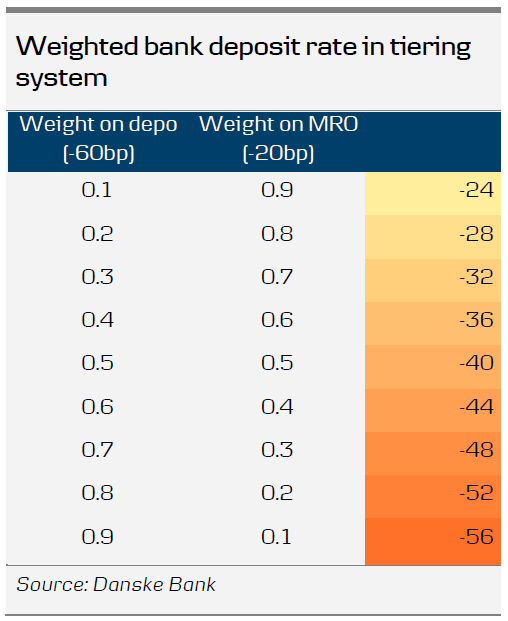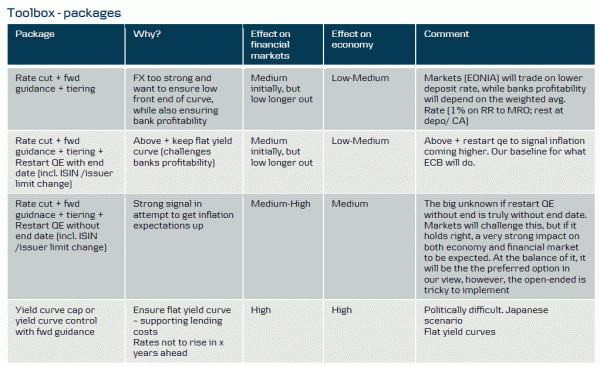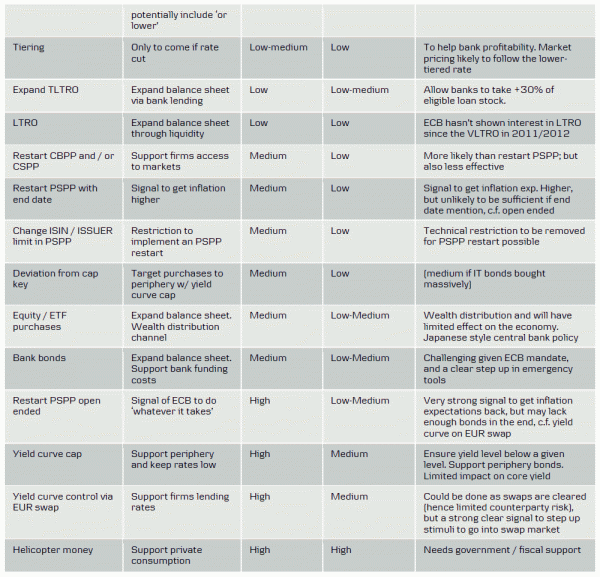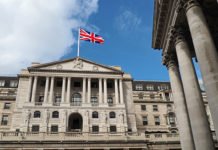- On the back of Draghi’s speech in Sintra this morning and Benoit Coeuré’s interview in the Financial Times yesterday, we change our call for the ECB outlook. We now expect ECB to cut rates by 20bp, introduce a tiering system, extended forward guidance, and restart QE in a package which could come already in September.
- In ECB perspective, nose-diving inflation expectations and a higher probability of looming risks will materialise has caused a change in the change in call.
When and how, not if
At the annual ECB conference in Sintra, Portugal, Draghi gave another seminal speech, similar to 2017. However, this time, Draghi opened the door wide open to new easing where he was specific that ‘coming weeks, the Governing Council will deliberate how our instruments can be adapted commensurate to the severity of the risk to price stability.’ Importantly, there has been a huge change from ECB in past 12 days since the last GC meeting as ECB will now act if there is no improvement in the in the economic outlook, so that inflation to target is threatened which compares to ECB acting if downside risks materialise.
Therefore, the question now remains when and how ECB will stimulate and not about if the will stimulate the market. As ECB will debate this over the next weeks it’s difficult to call exactly what the measures will entail (annex has a list of possibilities). Draghi has previously shown a preference to deploy multiple measures at the same time and we expect ECB to come with a three part package; rate cut, tiering and QE restart.
The market impact and most prominently, the market inflation based inflation expectations has been very benign to the ECB. The 5y5y has surged from record lows of 1.13% to 1.21% in a sign of credibility in the ECB’s new measures. However, the level is still very low and still far from ECB’s target so the ECB has to deliver and come with a big package to satisfy markets.
We expect ECB to open for further easing in the July meeting, and announcement in September, alongside new staff projections, but also acknowledge a risk to earlier announcement should market and economic sentiment suffer.
A Bloomberg source story just now suggested ECB to favour a rate cut as the primary tool.
Potential timeline of coming meetings
Rate cut
Today Draghi said that ‘We remain able to enhance our forward guidance by adjusting its bias [from current at ‘present levels’] and ‘further cuts in policy interest rates and mitigating measures to contain any side effects remain part of our tools.’ Consequently, we expect ECB to include ‘at present or lower’ levels in the July meeting, but only cut rates in September as part of a package together with restart of QE. As the Sintra piece entails a sense of urgency and bold statements, we a 20bp cut in the deposit rate and the MRO rate and 25bp in the lending rate, to the new rates being -60bp, -20bp and 0% respectively. That said, there are naturally a wide range of options of ECB possibility to cut, however we do expect a rate cut of at least 10bp and no more than 20bp. Should ECB ‘only’ come with a 10bp cut in September, we expect a further rate cut later this year as well. Markets are currently pricing a 10bp curve in September.
At the same time, we expect a tiering system announced in a format where banks can now deposit up to 40% of the reserve requirements at the MRO (from current 1%) and 60% at the deposit rate. ECB has previously expressed concern with the banks’ profitability and if their concern continues, the weighted average deposit rate should not decline from current -39bp (1% at MRO and 99% at deposit rate). That can be achieved by multiple combinations. We currently favour 60% at MRO and 40% at depo, but all options are on the table (see also table below). See also tiering in GBW from 29 March 2019 for further discussion of tiering system.
QE restart
Just similar to Coeuré yesterday and the ECB press conference 12 days ago, Draghi emphasised the considerable headroom that ECB still have on the APP and reiterated the ECJ ruling to buy bonds proportionally. As we already discussed, a lift of the ISIN and issuer limits seems a formality as ‘the limits we establish on our tools are specific to the contingencies we face’. Consequently, our baseline is that ECB will restart QE for the 12 months at a monthly pace of 45-60bn / month.
A conservative update of the ISIN limits to 50%, taking into account the already ECB PSPP holdings indicate approx. ECB 1.8trl primarily in the govie space. That means that if ECB would purchase with EUR40bn per month they would have room for 45months and 60bn per month gives 30months, i.e. plenty of room for ECB to implement QE.
The struggle to avoid negative yields to intensify
Further easing from the ECB points to more of the same. Investors will once again be forced further out on the curve in respect of both duration and credit to avoid the negative yields. It points to even flatter curve 10s30s as core and semi-core 10Y yields are now trading in negative or close to negative.
In Government Bonds Weekly from June 7, we recommended to enter a 10-20y flattener in France. It basically, reflects this view. QE will benefit France and the Japanese investor that likes France will be forced out on the curve to get at positive yield.
Periphery in general will benefit directly from a new QE programme given their relative high debt levels and not least ‘high’ yield levels. In periphery, we have been in strong favour of Spain relative to Italy given since the political uncertainty in Italy. However, it might be time to go long Italy even as BTP’s have already rallied strongly. There is little else to buy for investors.
In Yield Outlook:10Y Bund Yields stuck in negative territory that we published June 17 we had a 3M forecast for 10Y Bund Yields at -0.35%. We now lower that target to -0.45%.
Do not expect a text-book steepening of the curve
Normally, we would expect a steepening of the curve 2-10y when the central bank opens the door for rate cuts. However, this text-book reaction is less likely this time due to the struggle to avoid negative yields and the expectations that a new QE programme will be introduced. However, there are still some mitigating factors for the flattening trade and that is if we see a pick-up in market inflation expectations. Today, 5y5y inflation expectations have jumped 6bp to 1.21%.
But we doubt that inflation expectations will rise any significantly. Further easing from ECB will support the recovery in the Euro zone, but it is hardly a silver bullet.
Furthermore, the neutral real rate is still very low in the Euro zone and likely falling. We estimate it around -1% in Research Global: Euro area rate to stay very low for very long from June 13. In other words the neutral nominal depo rate is probably only slightly above zero.




